
Lalique 'Tete de Coq' Crystal Mascot with Original Box
A Lalique 'Tete de Coq' crystal mascot, height 18.5 cm. Comes with original box

Rene Lalique Naiade Car Mascot, Opalescent Glass, 1920s
A 1920s Rene Lalique glass Naiade car mascot opalescent cast glass, missing the original base and later glued to a frosted and coloured glass base, height 10 cm
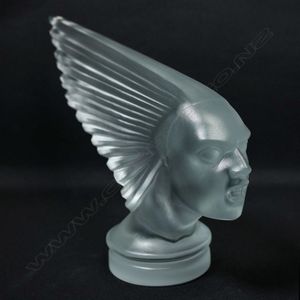
Frosted Glass 'Spirit of the Wind' Mascot Replica
A replica frosted glass mascot 'Spirit of the Wind' after the original by Lalique, Model No.1147 of c.1928, also known as 'Victoire'. Possibly Czech, length 24 cm

Lalique Swallow Mascot, Engraved Mark, Height 14cm
A Cristal Lalique 'Hirondelle' (Swallow) mascot after the original Model No.1143 of 1928. Engraved mark to base, height 14 cm
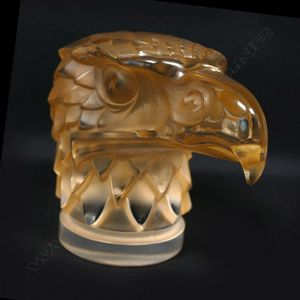
R Lalique Eagle's Head Paperweight with Ochre Patina
A 'Tete D'Aigle' (Eagle's Head) paper weight signed R Lalique, France clear glass with applied ochre patina. Note: in the 1950s this mascot was continued as a paperweight initially using an old mould with the moulded R. Lalique France mark in areas at the…

Rene Lalique Peacock Car Mascot
Rene Lalique, 'Tete de Paon' car mascot, model 1140, c. 1928, clear and frosted glass, intaglio 'R. Lalique' and numbered, seated in a chromed metal mount, height 21 cm; 17.5 cm (head). Provenance: Private Collection, Sydney
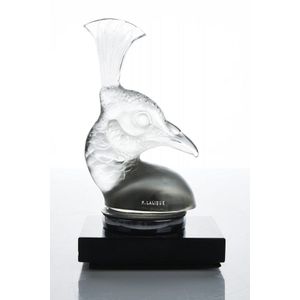
Rene Lalique Peacock Car Mascot
Rene Lalique, 'Tete de Paon' car mascot, model 1140, c. 1928, clear and frosted glass, intaglio 'R. Lalique' and numbered, small chips to feathers, seated in a chromed metal mount, height 21 cm; 17.5 cm (head). Provenance: Private Collection, Sydney

Lalique 'Chrysis' Crystal Car Mascot
Lalique 'Chrysis' crystal car mascot, depicting a kneeling female figure with arched back and flowing hair, raised on a circular base, in a frosted finish, incised Lalique France to base, height 13 cm

Lalique Archer Car Mascot in Violet Glass, 1928 Design
Lalique 'Archer' car mascot in violet glass, French, designed in 1928, stamped 'R. Lalique, France', 12.5 cm high
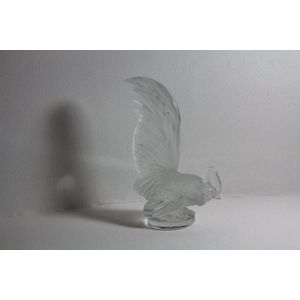
Lalique 'Coq Nain' Car Mascot, Post-1945 Production
A Lalique 'Coq Nain' car mascot, no, 1135, designed 1928, post 1945 production, 21 cm high.

Art Deco Lalique Glass Rooster Mascot
An Rene Lalique glass car mascot, 'Tete De Coq, circa 1928, model 1137, early Lalique France signature in capitals to neck, a stylised Art Deco model of a rooster's head upon on a circular base rim, (minor nibbles to the base indicate it was mounted on a…

Lalique 'Chrysis' Nude Car Mascot
Lalique 'Chrysis' car mascot, depicting a nude leaning backwards with hair outstretched, raised on a circular base, incised Lalique, France to the base, length 16 cm
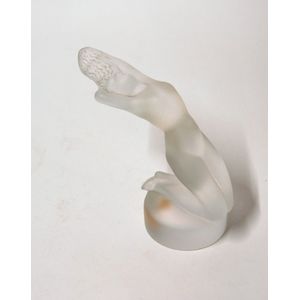
Lalique Chrysis Glass Sculpture
A modern Lalique naked woman 'Chrysis' glass sculpture, designed and produced by Rene Lalique from 1925 onwards, initially as a car mascot of Chrysis, the 'legendary beauty' in Greek mythology, emblematic as an 'evocation of grace, sensuality and…

R. Lalique Art Deco Victoire Car Mascot
An Art Deco style Victoire car mascot, signed 'R Lalique' the decorative radiator cap fashioned as a stylised warriors head with streamlined hair swept behind. Length 23 cm, height 22 cm

Rene Lalique Coq Nain Car Mascot
A Rene Lalique 'Coq Nain' car mascot, designed 1928, moulded in the form of a grazing cockerel, in frosted blue and clear glass, moulded 'R. Lalique' and 'France, 20.5 cm high. Provenance: James R. Lawson, Sydney, 5 February 1991, Mr Hans Mueller and Mrs…

Rene Lalique 'Coq Nain' Car Mascot
A Rene Lalique 'Coq Nain' car mascot, designed 1928, moulded in the form of a grazing cockerel, in frosted topaz and clear glass, moulded 'R. Lalique France, 20.5 cm high. Provenance: Mr Hans Mueller and Mrs Gertrud Mueller, Sydney. Literature: Felix…
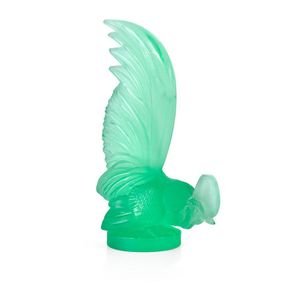
Rene Lalique 'Coq Nain' Car Mascot in Emerald Green
A Rene Lalique 'Coq Nain' car mascot, designed 1928, moulded in the form of a grazing cockerel, in frosted emerald green and clear glass, moulded 'R. Lalique France, 20.8 cm high. Provenance: Decorative and Fine Art, Antique Furniture, James R. Lawson,…

Lalique Rooster Mascot
Rene Lalique, Tête de Coq' Mascot, Model No. 1137, 1928, clear and frosted glass, moulded signature near base 'R. Lalique France, height 18 cm

Lalique 'Chrysis' Glass Car Mascots - Pair
A pair of Lalique glass 'Chrysis' car mascots, each of a kneeling nude female figure leaning backward with windswept hair and outstretched arms, design introduced in 1931, marked 'Lalique France', 14 cm high

Rene Lalique Pale Amethyst Glass Vitesse Mascot
A 'Vitesse' pale amethyst tinted glass mascot by Rene Lalique, model introduced 1929, moulded 'R.Lalique' and 'France' to either side of base, raised on a later nickel and wooden base, 21 cm high overall

Lalique Frosted Glass Car Mascot 'Chrysis' (14 cm)
A modern Lalique frosted glass car mascot, 'Chrysis'. engraved marks. Height 14 cm

Lalique Crystal Coq Nain Car Mascot
Lalique crystal 'Coq Nain' car mascot modelled from the original glass car mascot by the Lalique Company of Paris. Etched signature to base & 'made in France' paper label.

Frosted Crystal Lion Mascot by Lalique
A Lalique frosted crystal lion mascot, modelled with an open mouth, 'Lalique France' etched to base, 8 cm high

Lalique Frosted Glass Eagle Car Mascot
A Lalique frosted glass eagle car mascot, modelled as an eagle head, on an integral circular base, etched 'Lalique France' to base, 11 cm high

Lalique Amethyst Faucon Mascot with Silver Base
A Rene Lalique amethyst tint 'Faucon' mascot, circa 1925, Marcilhac catalogue number 1124, with original silver plate base, signed 'R. Lalique', 19.5 cm high.

Lalique Rooster Car Mascot
A Lalique glass rooster car mascot or hood ornament, 1978 and after, pattern 1135 from an original 1928 design. the rooster displaying his tail feathers and with his head low, wheel engraved signature of Lalique France with registration letter to base.…
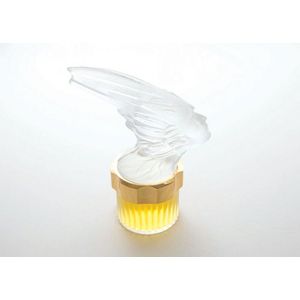
Lalique Falcon Scent Flask with Phoenix Stopper
Lalique Falcon collection 2000 scent flask frosted phoenix mascot stopper on fine column lobed cylindrical base, 17.5 cm high
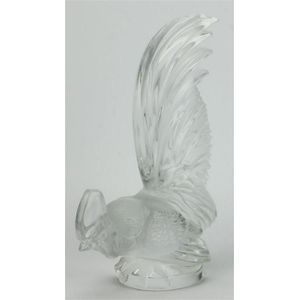
Lalique Coq Nain Car Mascot
Lalique 'Coq Nain' car mascot modelled from the original by the Lalique Company of Paris. Etched signature 'Lalique France' to the base. Condition good, minor wear to the base. Height 20.5 cm

Lalique Art Deco 'Chrysis' Car Mascot
A Lalique Art Deco 'Chrysis' radiator car mascot first designed 1931. Clear and frosted glass. Marcilhac number: 1183 signed 'Lalique R France' (post World War II mark). Height 13.5 cm
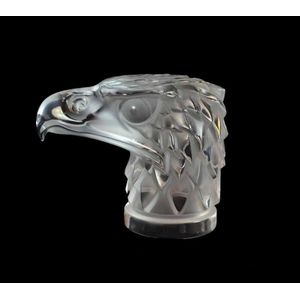
Lalique Eagle Radiator Mascot
A Lalique 'Tete D' Aigle (eagle) radiator car mascot first designed in 1928. Clear and frosted glass. Marcilhac guide number: 1138 signed 'Lalique R France' (post World War II mark). Height 10.7 cm

Rene Lalique Eagle Car Mascot
Rene Lalique 'Tete D'Aigle' car mascot in clear and frosted glass, moulded 'R.Lalique, France' to the side of neck feathers, with dark grey hue to the glass. Length 14 cm

Lalique Chrysis Car Mascot
Lalique 'Chrysis' car mascot of kneeling nude female figure leaning backward with windswept hair and outstretched arms. Height 12 cm

Frosted Crystal Eagle Head Car Mascot by Lalique
Lalique eagle head car mascot frosted crystal, etched signature mark

Lalique Frosted Crystal Rooster
Lalique 'Coq Nain' frosted crystal rooster modelled from the original glass car mascot by the Lalique Company of Paris. Etched signature to base and 'Made in France' paper label. Height 20.5 cm

Lalique Eagle Head Mounted Mascots on Glass Plinth (Pair)
A pair of Lalique Tete D'Aigle mounted mascots each eagle head mounted on graduated square glass plinth signed to rim Lalique France (2) 18.5 x 15 x 13 cm

Rene Lalique Clear Glass Swallow Mascot, 1928
A Rene Lalique clear glass 'Hirondelle' mascot, in the form of a swallow with fanned tail no. 1143, introduced 1928, moulded R Lalique France, (wings reduced) 14 cm high
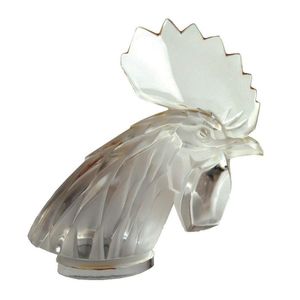
Lalique Rooster Head Car Mascot
A Lalique rooster head car mascot, the neck and head with stylised feathers, large plain comb, etched mark to base and paper label. Height 18 cm
 Loading more...
Loading more...